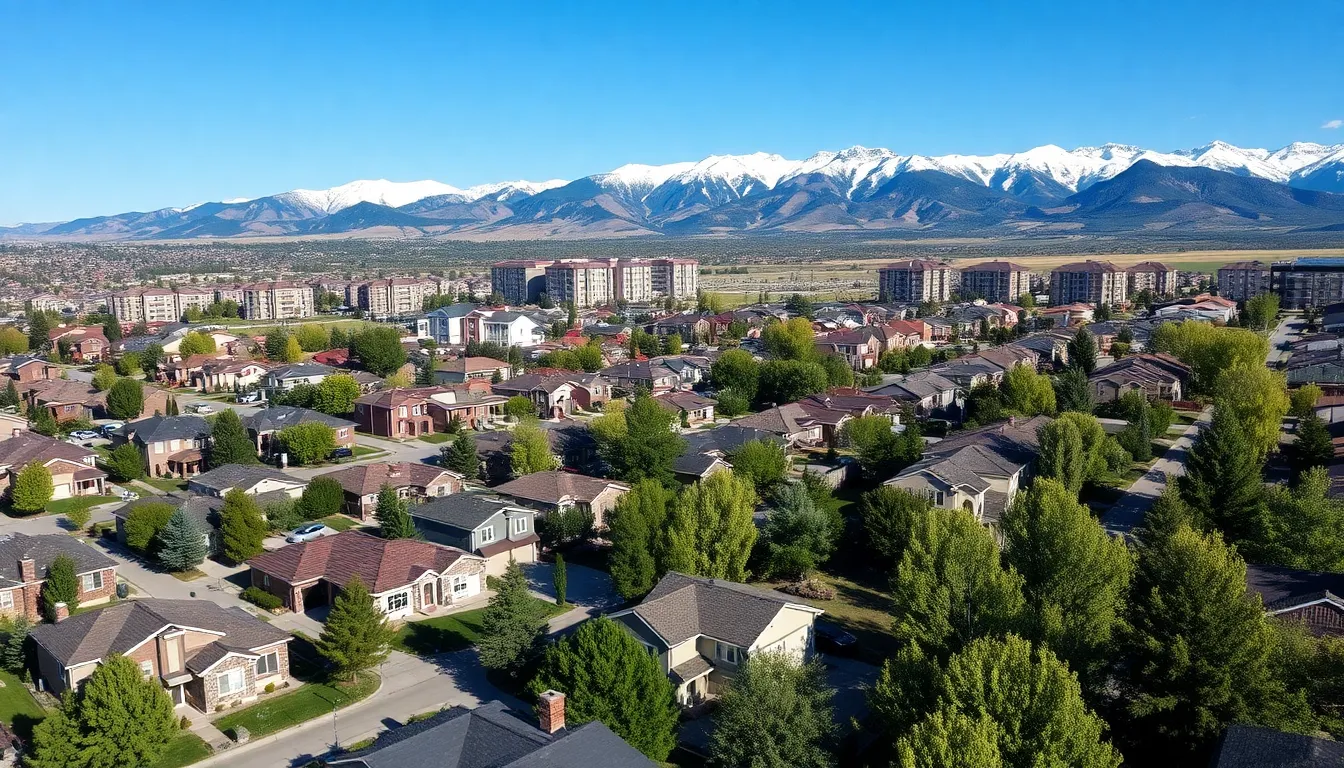When it comes to choosing where to plant roots, Colorado and Texas are two heavyweights in the ring. One boasts breathtaking mountains and a craft beer scene that could make even the pickiest hipster swoon. The other? A sprawling landscape of BBQ joints and a charm that’ll make you feel like you’ve stepped into a country song. But what about the cost of living?
It’s a showdown that goes beyond just the price of tacos and lattes. With housing, groceries, and those pesky taxes in the mix, understanding the financial landscape can feel like deciphering a secret code. So, whether you’re dreaming of snow-capped peaks or wide-open plains, let’s break down the numbers and see which state offers the best bang for your buck. After all, who doesn’t want to live where their paycheck stretches just a little further?
Table of Contents
ToggleOverview of Cost of Living
Comparing the cost of living in Colorado and Texas reveals distinct differences across various categories. Housing costs in Colorado are generally higher than those in Texas, with the median home price in Colorado Springs at approximately $490,000 compared to around $300,000 in Austin. Monthly rent for a one-bedroom apartment averages around $1,800 in Denver, while Dallas residents pay about $1,500.
Groceries also vary significantly between both states. A person in Colorado spends around $400 monthly on groceries, whereas residents in Texas often spend about $350. When it comes to transportation, gas prices in Texas tend to be lower, averaging $3.20 per gallon compared to Colorado’s $3.50.
Utilities present another difference; Colorado residents face average utility bills of $130, while Texas residents see bills around $120. Taxes play a crucial role as well. Colorado’s income tax rate stands at 4.55%, whereas Texas boasts no state income tax, making it attractive for high earners.
Healthcare costs show varying trends too. Average healthcare expenditures can reach $5,000 annually in Colorado, contrasted with about $4,500 in Texas. Additionally, leisure activities may also impact residents’ overall expenses. Colorado’s recreational activities, particularly outdoor pursuits, often incur higher costs than Texas’s entertainment options.
Overall, cost of living considerations greatly influence decisions regarding relocation. Evaluating housing, groceries, transportation, utilities, taxes, healthcare, and entertainment provides insight into the financial realities of living in Colorado versus Texas.
Colorado Cost of Living

The cost of living in Colorado varies significantly across different categories. Housing costs stand out as a major factor.
Housing Expenses
Housing expenses in Colorado are notably higher than in many states. The median home price in Colorado Springs reaches around $490,000, while Austin’s median is roughly $300,000. Renting also proves costly; a one-bedroom apartment in Denver averages $1,800. Comparatively, residents in Dallas pay about $1,500 for similar accommodations. Colorado’s strong demand for housing contributes to these elevated prices.
Transportation Costs
Transportation costs reflect a mix of expenses in Colorado. Gas prices average $3.50 per gallon, which exceeds Texas’s $3.20. Daily commuting can impact monthly budgets, especially in urban areas. Public transportation options are expanding but can still lag behind Texas’s well-developed systems. Travelers and commuters should factor in these variations when evaluating relocation.
Healthcare Costs
Healthcare costs in Colorado represent a significant expense for residents. On average, individuals spend approximately $5,000 annually on healthcare, exceeding Texas’s $4,500. Quality of care often drives these costs higher, as Colorado boasts strong health services. Availability and access to specialists may influence choices, making healthcare considerations essential during the decision process.
Utilities and Groceries
Utility bills in Colorado slightly exceed those in Texas. Average monthly utility costs in Colorado total around $130, while Texas averages about $120. Grocery expenses also differ significantly; Coloradans spend approximately $400 monthly compared to Texas’s $350. Seasonal variations in utility usage further complicate budgeting in Colorado. Shoppers should recognize these differences when planning their finances and evaluating overall costs.
Texas Cost of Living
Texas offers a lower cost of living compared to many other states, with particular advantages in housing and taxes.
Housing Expenses
Home prices in Texas typically remain affordable. The median home price in Austin stands at about $300,000, significantly lower than in many Colorado cities. Rent for a one-bedroom apartment averages around $1,500 in Dallas, making it budget-friendly for residents. Many areas also feature diverse housing options, catering to various lifestyle preferences. The overall affordability of housing contributes substantially to Texas’s appeal for those looking to relocate.
Transportation Costs
Transportation expenses in Texas reflect a favorable landscape. Gas prices average $3.20 per gallon, providing relief for daily commuters. Public transportation, particularly in larger cities like Houston and Dallas, supports extensive commuting needs. A range of options, including buses and rail systems, enhances accessibility. For individuals relying on personal vehicles, lower insurance rates may also significantly reduce overall transportation costs.
Healthcare Costs
Healthcare costs in Texas are another area of consideration. Residents typically spend around $4,500 annually on medical expenses, creating opportunities for budget-conscious individuals. Quality healthcare remains accessible, with many facilities offering comprehensive services. The variety of healthcare providers allows for competitive pricing and choice. As a result, Texans benefit from both affordable and quality healthcare options.
Utilities and Groceries
Utility expenses in Texas are generally manageable. Monthly utility bills average about $120, slightly lower than in Colorado. Grocery costs also contribute to the state’s affordability, with average monthly expenses around $350. Well-stocked supermarkets and farmers’ markets provide diverse choices for residents, ensuring access to quality products. Both utilities and groceries maintain budget-conscious lifestyles, enhancing overall living standards.
Comparing Colorado and Texas
Both states present distinct financial landscapes that impact daily living. Colorado carries a higher overall cost of living, largely due to its elevated housing prices. For example, the median home price in Colorado Springs reaches around $490,000, contrasting with Austin’s approximately $300,000. Monthly apartment rents differ significantly too, averaging $1,800 in Denver versus about $1,500 in Dallas.
Transportation expenses further differentiate the states. Gasoline costs in Colorado average $3.50 per gallon, while Texas sees lower prices at approximately $3.20. Budgeting for groceries also varies, where Coloradans spend about $400 monthly compared to $350 for Texans. Tax implications play a crucial role, as Colorado’s 4.55% income tax stands in stark opposition to Texas’s absence of state income tax, appealing to higher earners.
Overall Cost Analysis
Overall, Texas offers more affordable living conditions. Colorado’s healthcare costs average $5,000 annually and eclipses Texas’s $4,500 spending. Utilities remain slightly pricier in Colorado, averaging $130 monthly versus $120 in Texas. Residents in Colorado may find their budgets stretched thinner, particularly with higher leisure activity costs. Ultimately, Texas presents a more cost-effective option, especially regarding housing and healthcare.
Quality of Life Considerations
Quality of life perceptions fluctuate between states. Colorado showcases stunning natural landscapes and recreational opportunities, attracting outdoor enthusiasts. The state’s craft beer culture draws many residents, contributing to its vibrant social scene. Texas, however, boasts rich cultural heritage and diverse culinary offerings, such as world-renowned BBQ. Urban centers like Austin and Dallas provide extensive entertainment and dining options. Although Colorado offers an appealing lifestyle, Texas stands out with lower living costs, making it an attractive choice for budget-conscious individuals prioritizing lifestyle quality.
Choosing between Colorado and Texas involves weighing lifestyle preferences against the cost of living. While Colorado offers breathtaking scenery and a vibrant culture it comes with higher housing and healthcare expenses. On the other hand Texas provides a more budget-friendly environment with no state income tax and lower overall living costs.
Ultimately the decision hinges on individual priorities. Those seeking outdoor adventures and a unique craft scene may lean toward Colorado. Conversely individuals looking for affordability and a rich cultural experience might find Texas more appealing. Understanding these financial dynamics will help potential residents make informed choices that align with their lifestyle goals.






